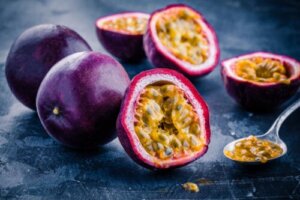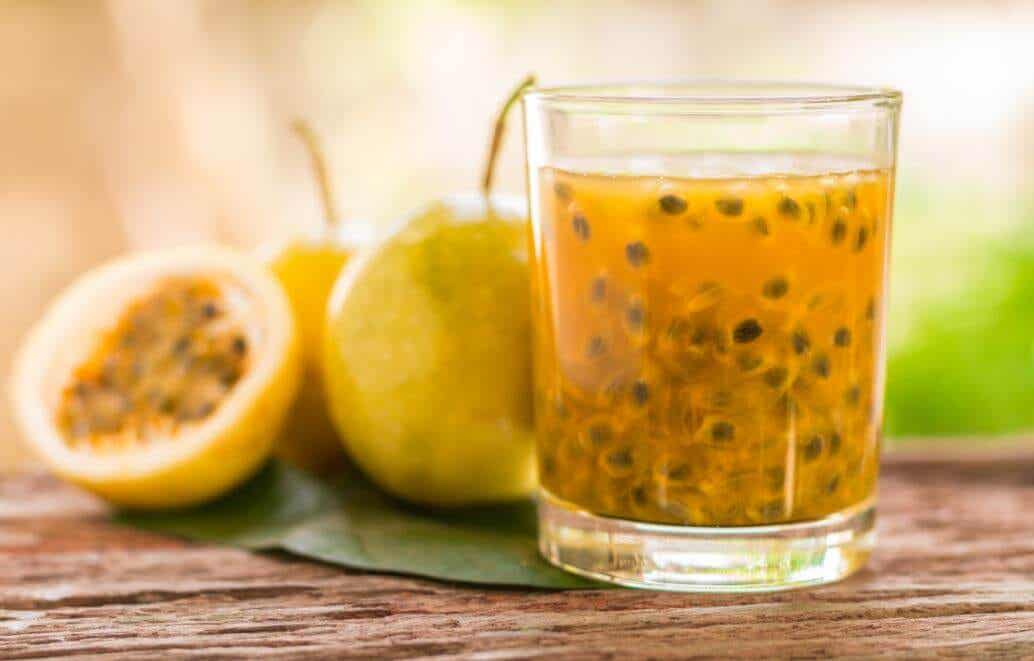Passion Fruit: Origin, Types, and Characteristics


Written and verified by the nutritionist Maria Patricia Pinero Corredor
Passion fruit comes from a climbing plant with the scientific name Passiflora edulis flavicarpa. The genus has about 400 species. It belongs to the same family as Curuba (P. mollisina), sweet granadilla (P. ligularis), and badea (P. quandrangularis).
Other popular names for passion fruit include chinola, parcha, parchita, pasionaria, and curubo, among others. It’s a tropical fruit originating from the Amazon and is prized for its sweet and sour flavor. Its gastronomic use is wide, since it can be used to prepare jellies, jams, juices, desserts, liquors, soft drinks, and even infusions.
Passion fruit juice represents between 30% and 40% of the whole fruit and its nutritional value stands out in vitamin C, vitamin A, and soluble fiber. Do you want to know more about its properties?
The origin of passion fruit
Passion fruit is native to Brazil and was used by the Aztecs to make refreshing drinks. Spanish missionaries brought it to Europe in the 16th century and, observing the cross-like marks of “Christ’s passion” on its flower, named it Passiflora.
There are many varieties known, and each one is typical of each country. For example, the sweet granadilla is spread throughout South America, in Kenya and Hawaii. The cholupa variety is found in South America, and the curuba variety is native to Colombia. In Thailand, Malaysia, and Indonesia, the baldea variety is cultivated.
Passion fruit is symbolic of enormous economic and nutritional wealth. The beauty of its flower is the reason for its use as an ornamental plant in Europe. However, in America, the fruit is consumed.
We think you may be interested in reading this, too: The Longan or Dragon’s Eye: How Nutritious Is this Exotic Fruit?
Passion fruit characteristics
Passion fruit plants are climbers and perennials. Its fruits vary in size and color according to the species, from yellow to purple-brown or violet.
They’re round or oval berries, inside which are the seeds. Its flavor resembles that of guava and is described as both sweet and sour. Inside its hard, smooth shell is the pulp, enclosed in a membranous, gelatinous, transparent, juicy, and sweet and sour sac.
Passion fruit has an important market as a fresh fruit. According to some researchers, it can be used in the production of juices, nectars, concentrates, syrups, and jams. The peel has high fiber content and the seeds have protein and fat. For this reason, it can also be used as a raw material in animal feed.
This group of experts considers that the 86% of the water it contains and the low concentration of sodium makes it an excellent diuretic. It provides 12% of simple carbohydrates, such as glucose, fructose, and sucrose.
The vitamin C content is 20 milligrams per 100 grams of edible part; that is, one-third of the recommended value. Among the multiple benefits of vitamin C, Castillo-Velarde highlights its antioxidant capacity to prevent certain chronic pathologies.
Passion fruit with yellow pulp contains beta-carotene precursors of vitamin A. The Technical Guide for the Cultivation of Passion Fruit indicates a contribution of 680 milligrams of active vitamin A. This vitamin is essential for visual health and reproduction.

Like this article? You may also like to read: Acidic and Semi-acidic Fruits: What Are They and What Are Their Effects?
Other types of Passiflora
The name passion fruit includes several edible species of the Passiflora genus. They differ only in the type of fruit, size, color, and flavor.
Purple passion fruit, or granadilla
This is the most common type of Passiflora in Europe, and its scientific name is Passiflora edulis sims. It has a gelatinous texture, is refreshing, juicy, and has a sweet and sour taste.
It’s considered by many to be the best passion fruit and is native to South America, from southern Brazil to northern Argentina. The fruit resembles a rounded egg with a diameter of 4 to 8 centimeters.
When ripe, the shell, which is thick and hard, wrinkles. The external color varies between violet and dark purple, while the pulp varies between greenish and orange.
Granadilla dulce
This is also known as Passiflora ligularis. It has an oval shape and measures about 11 centimeters, with one of its ends ending in a point. The skin is yellowish or orange and its pulp is gray or pale.
It’s distributed from Central Mexico to Central and South America. The National University of Colombia reports that the main solids of this variety are natural sugars dissolved in the juice. Glucose, sucrose, and fructose account for 75% of all components.
Yellow passion fruit
Passiflora edulis flavicarpa is known as yellow passion fruit. It is similar to the purple passion fruit, only the skin color is yellow, and they’re much larger. It can reach up to 90 grams of weight.
The magazine Bioresource Technology highlights it for its important contribution of soluble fiber, such as pectin. This fiber is abundant in the cell walls and is used as a gelling and stabilizing agent.

Badea or royal passion fruit
Its scientific name is Passiflora quadrangularis, and it’s one of the largest varieties, as it can measure up to 26 centimeters in length. The shape is elongated and the peel is thick, with several protuberances.
A group of food engineers says that this variety of parchita is also known as giant tumbo, parcha real, or quijón in Spanish. Its pulp is slightly acidic in taste and smell, so it represents the optimal type for soft and refreshing drinks. Its leaves are used as a sedative and tranquilizer.
Curuba or tumbo serrano
In the book Passifloras they comment that, thanks to its organoleptic and nutraceutical characteristics, curuba has the greatest commercial potential for export. Its scientific name is Passiflora mollisima.
It’s known in English as banana passion fruit, as tacos in Ecuador, and parcha in Venezuela. Curuba is its common name in Bolivia. The fruit measures about 10 centimeters and is oval and elongated.
Maracuyá granadita from China
The granadita de China is a specific variety of passion fruit known to science as Passiflora edulis. It’s a climber that can reach up to 10 meters in height, with shallow roots and white flowers. It’s also known as mburucuyá and grows wild in the Paraná forest in Brazil.
The fruit is spherical or oval in shape and can grow up to 10 centimeters long. It has a yellow or purple color when ripe and weighs between 80 and 90 grams.
It’s used as a fruit for direct consumption or prepared as juice, which represents 40% of all fruit. It has a yellow color due to the presence of carotenoids.
Chulupa or gulupa
The cholupa is the species Passiflora malimorfis, whose skin is yellowish green or mahogany brown. The pulp is also yellow and contains many seeds. It’s native to Colombia and is not yet well characterized.
The Revista Colombiana de Ciencias Hortícolas published that the fruit is consumed and used in the food industry because of its contribution of simple carbohydrates and vitamin C. It’s also used for skin rejuvenation.
Try passion fruit
Any variety of passion fruit awakens the senses with its peculiar aroma and flavor. In addition, they all provide a good proportion of vitamin C, fiber, and simple sugars, which give a sweet and sour combination ideal for preparing nectars, juices, sauces, jellies, or jams.
To make the best use of its vitamin C value, you should consume it fresh or drink its freshly prepared juices. Don’t hesitate to give this tasty tropical fruit a try!
All cited sources were thoroughly reviewed by our team to ensure their quality, reliability, currency, and validity. The bibliography of this article was considered reliable and of academic or scientific accuracy.
- López Castro, Mariantonia; Beltrán Cifuentes, Martha Cecilia; Cardona Lancheros, Jorge Eduardo; Yepes Giraldo, Héctor Fabián LA FRUTA DE LA PASIÓN, POTENCIAL CONTRIBUCIÓN DE LA NATURALEZA A LA SEGURIDAD ALIMENTARIA Investigaciones Andina, vol. 8, núm. 12, 2006
- Castillo-Velarde, Edwin Rolando. (2019). Vitamina C en la salud y en la enfermedad. Revista de la Facultad de Medicina Humana, 19(4), 95-100. https://dx.doi.org/10.25176/RFMH.v19i4.2351
- Mario Alfonso García. GUIA TECNICA DEL CULTIVO DE LA MARACUYA. PROGRAMA MAG-CENTA-FRUTALES. CENTRO NACIONAL DE TECNOLOGIA AGROPECUARIA Y FORESTAL “Enrique Álvarez Córdova”. Impresos múltiples, 2010. 33 p.p. Disponible en: http://centa.gob.sv/docs/guias/frutales/GUIA%20MARACUYA%202011.pdf
- Luz Marina Melgarejo. GRANADILLA (Passiflora ligularis Juss): CARACTERIZACIÓN ECOFISIOLÓGICA DEL CULTIVO. 2015. Disponible en: https://uneditorial.net/uflip/granadilla-caracterizacion-ecofisiologica/pubData/source/Granadilla.pdf
- Eloısa Rovaris Pinheiro, Iolanda M.D.A. Silva, Luciano V. Gonzaga, Edna R. Amante, Reinaldo F. Teo´filo, Ma´rcia M.C. Ferreira, Renata D.M.C. Amboni, Optimization of extraction of high-ester pectin from passion fruit peel (Passiflora edulis flavicarpa) with citric acid by using response surface methodology, Bioresource Technology 99 (2008) 5561–5566.
- Liliana Acurio; Andrea Zamora; Diego Salazar; Lander Pérez; Alex Valencia. Propiedades físicas, químicas, térmicas y nutricionales de la badea (Passiflora quadrangularis). 2015, Agroind Sci. (2015). 95-101 p.p.
- Adalberto Rodríguez Carlosama, Fábio Gelape Faleiro , Marisol Parra Morera y Ana Maria Costa. PASIFLORAS especies cultivadas en el mundo. Proimpres. Brasilia, 2020. Disponible en: https://www.researchgate.net/publication/343376871_Curuba_Passiflora_tripartita_var_mollissima_y_Passiflora_tarminiana
- FORERO, RANDY, ORTIZ, EMIRO, DE LEÓN, WADITH, GÓMEZ, JUAN CAMILO, & HOYOS-CARVAJAL, LILLIANA. (2015). Análisis de la resistencia a Fusarium oxysporumen plantas de Passiflora maliformis L.. Revista Colombiana de Ciencias Hortícolas, 9(2), 197-208. https://doi.org/10.17584/rcch.2015v9i2.4174
This text is provided for informational purposes only and does not replace consultation with a professional. If in doubt, consult your specialist.








